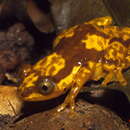Description
provided by AmphibiaWeb articles
A small West African forest Afrixalus (males 19-23 mm, females 23-27 mm) with yellowish white dorsum, with a darker or lighter brown pattern of a constant shape. The males lack asperities (Schiøtz 1999).The form was originally described as a subspecies of the central African A. laevis (Schiøtz 1967), but the differences between the two seem to warrant specific separation. The characteristic pattern of A. vibekae is thus only found in very few of the otherwise very variable A. laevis and the voice is different (Schiøtz 1999).The forest-living species A. laevis, A. lacteus, and A. uluguruensis are similar and possibly closely related (Schiøtz 1999).This account was taken from "Treefrogs of Africa" by Arne Schiøtz with kind permission from Edition Chimaira publishers, Frankfurt am Main, and updated by A. Schiøtz, 2008.
- IUCN, Conservation International, and NatureServe. (2006). Global Amphibian Assessment: Afrixalus vibekensis. www.globalamphibians.org. Accessed on 2 September 2008.
- Rödel, M.-O. (2000). ''Les communautés d'amphibiens dans le Parc National de Taï, Côte d'Ivoire. Les anoures comme bio-indicateurs de l’état des habitats.'' Sempervira, 9, 108-113.
- Rödel, M.-O., and Branch, W.R. (2002). ''Herpetological survey of the Haute Dodo and Cavally forests, western Ivory Coast, Part I: Amphibians.'' Salamandra, 38, 245-268.
Distribution and Habitat
provided by AmphibiaWeb articles
This species has been recorded from several disjunct localities in West African forest. In western Côte d'Ivoire it has been found on Mt. Nimba (bordering Guinea and Liberia, from which this species has not yet been reported) (Schiøtz 1967). It also occurs in Taï National Park and Haute Dodo Classified Forest in southwestern Côte d'Ivoire (Rödel 2000, Rödel and Branch 2002). In southwest Ghana it has been reported from Bobiri Forest Reserve (Schiøtz 1967).
Life History, Abundance, Activity, and Special Behaviors
provided by AmphibiaWeb articles
This frog is quiet and secretive. The breeding locality seems to be stagnant swamps in the dense forest (Schiøtz 1999). Eggs may be laid either on leaves above water, or in the water (IUCN 2006). The voice is an inconspicuous buzzing with low intensity, followed by a creaking sound. The frequency-intensity maximum is high, about 6000 cps (Schiøtz 1999).
Life History, Abundance, Activity, and Special Behaviors
provided by AmphibiaWeb articles
It depends on forest edge habitat, occurring along roads and in gaps created by treefalls. It is found in several protected areas: Taï National Park and Haute Dodo Classified Forest, in Côte d'Ivoire, and in the Bobiri Forest Reserve, Ghana (IUCN 2006).
Afrixalus vibekensis
provided by wikipedia EN
Afrixalus vibekensis, sometimes known as the Nimba banana frog, is a species of frogs in the family Hyperoliidae. It is confirmed to exist in two locations in Côte d'Ivoire and one in Ghana, and it possibly occurs in Guinea and Liberia.[1][2][3] It was originally described as subspecies of Afrixalus laevis. The type locality is in Côte d'Ivoire near Mount Nimba.[2]
Description
Adult males measure 19–23 mm (0.7–0.9 in) and adult females 23–27 mm (0.9–1.1 in) in snout–vent length. The dorsum is yellowish white with a darker or lighter brown pattern; the pattern does not vary between individuals (as in Afrixalus laevis). Males lack asperities.[3]
The male advertisement call consists of an inconspicuous buzzing with low intensity, which is then followed by a creaking sound.[3]
Habitat and conservation
Afrixalus vibekensis occurs in forest edge habitats such as forest road margins and tree-fall gaps. Breeding takes place in small temporary ponds and puddles. The eggs are laid either on leaves above water or directly in the water.[1][3]
This species is difficult to find and might be under-recorded. It is threatened by habitat loss caused by agricultural encroachment, expanding human settlements, and logging. It occurs in the Taï National Park and Haute Dodo Classified Forest in Côte d'Ivoire and in the Bobiri Forest Reserve and Butterfly Sanctuary in Ghana.[1]
References

- license
- cc-by-sa-3.0
- copyright
- Wikipedia authors and editors
Afrixalus vibekensis: Brief Summary
provided by wikipedia EN
Afrixalus vibekensis, sometimes known as the Nimba banana frog, is a species of frogs in the family Hyperoliidae. It is confirmed to exist in two locations in Côte d'Ivoire and one in Ghana, and it possibly occurs in Guinea and Liberia. It was originally described as subspecies of Afrixalus laevis. The type locality is in Côte d'Ivoire near Mount Nimba.
- license
- cc-by-sa-3.0
- copyright
- Wikipedia authors and editors

